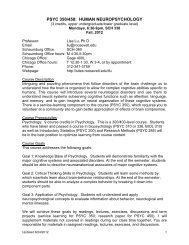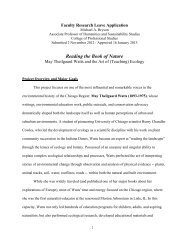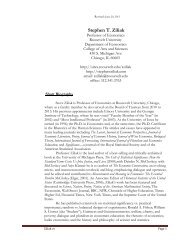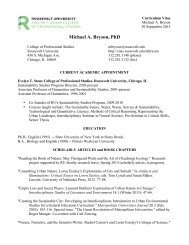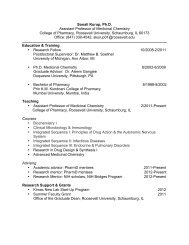Mothering Violence: Ferocious Female Resistance in Toni ...
Mothering Violence: Ferocious Female Resistance in Toni ...
Mothering Violence: Ferocious Female Resistance in Toni ...
Create successful ePaper yourself
Turn your PDF publications into a flip-book with our unique Google optimized e-Paper software.
34 amanda putnam<br />
her own mother, Eva, “‘did you ever love us?’” (ibid., 67). Eva, angered by<br />
the question, <strong>in</strong>dicates she did not. Thus, it is not surpris<strong>in</strong>g that Hannah<br />
repeats this type of phras<strong>in</strong>g (and abuse) to her own daughter, not will<strong>in</strong>gly<br />
recogniz<strong>in</strong>g the damage <strong>in</strong>flicted on herself <strong>in</strong> the same situation. But Sula’s<br />
maternal abandonment is real and affects her self-image. Suddenly, Sula is<br />
vulnerable, s<strong>in</strong>ce (like Pecola), if a young black girl cannot expect her own<br />
mother to enjoy her unconditionally, it is unlikely that the rest of the world<br />
will do so.<br />
Comprehend<strong>in</strong>g her vulnerability for the first time, Sula recovers via<br />
violence toward another child. The scene quickly changes from Sula’s household<br />
6 to Sula and Nel play<strong>in</strong>g near a river and trees with a little boy named<br />
Chicken Little. After climb<strong>in</strong>g up and down a tree with the little boy, Sula<br />
playfully “picked him up by his hands and swung him outward then around<br />
and around . . . [and] when he slipped from her hands and sailed away out<br />
over the water they could still hear his bubbly laughter” (Morrison 1982,<br />
60–61). However, the boy does not emerge from the water; and <strong>in</strong>stead of<br />
try<strong>in</strong>g to save him, both girls wait to see what happens. In fact, the first th<strong>in</strong>g<br />
Nel says is “‘Somebody saw,’” (61) suggest<strong>in</strong>g that the girls are far more<br />
concerned about someone see<strong>in</strong>g them watch a child drown than the actual<br />
passivity of their actions. The girls do not tell anyone what happened, and<br />
Chicken Little’s water-engorged body is eventually found and buried a few<br />
days later.<br />
But the emotional violence of discover<strong>in</strong>g Sula’s mother’s passive hostility<br />
for her helps create a detachment <strong>in</strong> Sula, allow<strong>in</strong>g her to watch death<br />
and other tragedies from an easy distance. Sula later watches her mother<br />
burn to death <strong>in</strong> their backyard, and grandmother Eva believes the girl did<br />
so out of twisted curiosity. Hav<strong>in</strong>g learned from her mother the possibility<br />
of lov<strong>in</strong>g, but rema<strong>in</strong><strong>in</strong>g remote, and hav<strong>in</strong>g learned from her grandmother<br />
that murder may be a part of family life (as Eva murders her own son), Sula<br />
rema<strong>in</strong>s aloof from her mother’s fiery death, just as she was when she accidently<br />
killed Chicken Little.<br />
In fact, later <strong>in</strong> the novel, it is clear that Sula connects her emotional<br />
trauma from her mother with her personal detachment. The <strong>in</strong>tense pa<strong>in</strong> of<br />
learn<strong>in</strong>g her mother does not like her bl<strong>in</strong>ds Sula to feel<strong>in</strong>g a normal amount<br />
of social compassion, which then manifests itself through violence toward<br />
others. Sula recounts her new understand<strong>in</strong>g:<br />
As will<strong>in</strong>g to feel pa<strong>in</strong> as to give pa<strong>in</strong>, to flee pleasure as to give pleasure,<br />
hers was an experimental life—ever s<strong>in</strong>ce her mother’s remarks sent her



